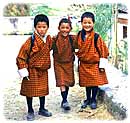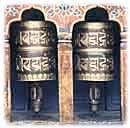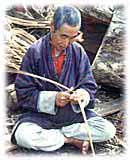 |
 |
|
 |
 |
A Little About Bhutan
BHUTAN: Located between China and India, the kingdom measures 110 miles from north to south and 200 miles from east to west. The country is all mountainous with the exception of the southernmost end which is a continuation of the plains of northern India. Bhutan's population is around 750,000. The government is a monarchy and the king, Jigme Singye Wangchuk, makes himself accessible to all of his subjects and is well liked. The official language is Dzongkha, but English is taught in the schools. The religion, Drukpa Kagyu, a form of Tantric Buddhism, regulates all aspects of life. Bhutan's economy is agricultural and the majority of people live in small rural villages. The Bhutanese dress in their ancient traditional styles, the men wearing the gho, a long robe tied around the waist, and the women the kira, an ankle length dress made of colorful finely woven fabrics. DZONG: The word “Dzong” loosely translated means a fortress. For over three hundred years these formidable looking castles, built mostly on mountain spurs overlooking valleys, have served as a defense against attack or invasion. The dzongs house monasteries and also serve as government administrative centers. GURU RIMPOCHE: Guru Rimpoche (“Precious Master”) is one of the most important religious figures in Bhutan. He was a Tibetan lama who arrived in Bhutan in the Seventh Century and introduced Tantric Buddhism to the country. He is credited with many magical feats. PARO: Located in the Paro Valley in western Bhutan, Paro is the location of the country's only international airport. In the 19th Century, Paro was the seat of government and the commercial center of the country. Many important religious and historical sites are located in Paro. THIMPHU: The capital city of Bhutan, Thimphu lies in a wooded valley along the banks of the Thimpu Chhu (river). This tiny capital city has a population of only 40,000 people and is probably the only world capital with no traffic lights. WANGDUE PHODRANG: Founded in 1638, the Wangdue Phodrang Dzong stands on a ridge which commands a view of two river valleys. Zhabdrung, the religious leader who unified the country in the 17th Century, was told by a diety that he could bring the whole country under his rule if he built a dzong on this ridge, which has the shape of a sleeping elephant. He built the dzong and named it Wangduephodrang, “wangdue” meaning “to bring under one's power.” PUNAKHA: The Punakha Dzong lies at the junction of the Phochhu and Mochhu rivers. Built in 1637, the dzong played an important role in the country's history. It was here that the hereditary monarchy was established on December 17, 1907, when Sir Ugyen Wangchuck became the first monarch. Today the dzong is the winter residence of the Je Khenpo, the chief abbot of Bhutan. BUMTHANG: Bumthang is a region in central Bhutan and is often referred to as the country's cultural heartland. Monasteries, ancient temples and palaces are found throughout the countryside. JAKAR: The major trading center for the Bumthang region, Jakar is a base for visiting the many sights of central Bhutan. The site for the Jakar Dzong was chosen when a white bird rose into the air and and settled on a cliff overlooking the valley. This was looked upon as being a good omen, and the Jakar Dzong, “the Dzong of the White Bird,” was constructed in 1549. TRONGSA: Trongsa is located in the center of the country and is surrounded by high mountain passes. The Trongsa Dzong, the most impressive in the kingdom, is said to be one of the most magnificent works of traditional Bhutanese architecture. Its location was chosen because, while meditating, a member of the ruling family had a vision of a butter lamp burning, signifying that this was a sacred place.
|
| CST 2027100-40 | Privacy Policy |







